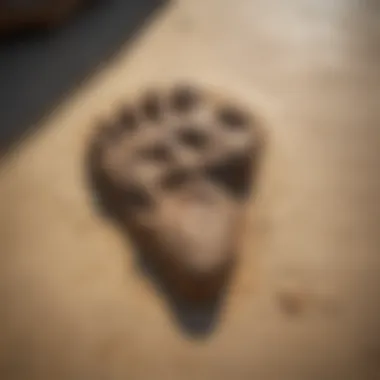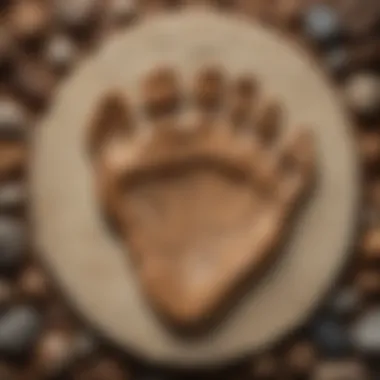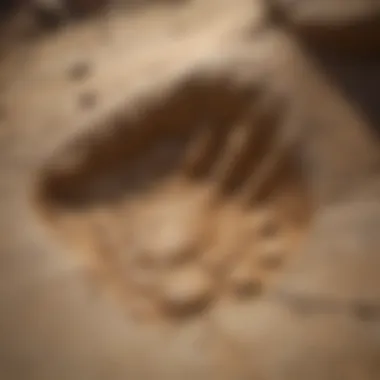Unveiling the Enigmatic Universe of Dinosaur Footprint Fossils for Sale


Rock and Fossil Identification
Dinosaur footprint fossils are a special category of rocks and fossils sought after by collectors and enthusiasts. Understanding the types of rocks and fossils that may contain these unique footprints is crucial. Sedimentary rocks like sandstone and mudstone are common hosts for dino footprints due to their ability to solidify impressions over time. When identifying dinosaur footprints, look for distinct characteristics such as three-toed markings for theropods or circular imprints for sauropods. Utilizing tools like magnifying glasses and rock hammers can aid in the identification process.
Collecting Tips and Techniques
For aspiring collectors, practicing best collecting practices is essential to preserve the integrity of the dinosaur footprint fossils. Locating prime collecting sites typically involves researching areas with known fossil deposits or geological formations conducive to preserving footprints. Upon discovery, safely extracting specimens involves delicate techniques such as using brushes and chisels to avoid damaging the fossils. Proper documentation of the specimen's location and orientation is also crucial for scientific and historical value.
Preservation and Display
Preserving dinosaur footprint fossils requires meticulous care to prevent deterioration. Techniques like gently cleaning the fossils with brushes and using consolidants to strengthen fragile areas can help prolong their lifespan. When it comes to storage, storing the fossils in acid-free containers with cushioning materials to prevent friction is recommended. Creative display ideas include mounting the fossils on stands or in shadow boxes with accompanying information labels to enhance their educational value.
Geological Insights
Delving into the geological context of dinosaur footprint fossils unveils a world of fascinating discoveries. Understanding the geological formations that preserved these footprints offers insights into the ancient environments and ecosystems where dinosaurs roamed. The historical significance of dinosaur footprints lies in their contribution to paleontological research, shedding light on the behavior and anatomy of prehistoric creatures. Notable discoveries in the field, such as the Dampier Peninsula tracks in Australia or the Paluxy River tracks in Texas, continue to expand our knowledge of dinosaur behavior and habitats.
Introduction
In the vast world of paleontology and fossil collecting, dinosaur footprint fossils stand out as intriguing relics that offer a unique window into the ancient past. This section serves as a gateway to the exploration of dinosaur footprint fossils available for sale. By delving into the allure, historical significance, and intricacies of acquiring these fossils, readers will embark on a journey of discovery and appreciation for these one-of-a-kind collector's items. From uncovering the mysteries of prehistoric creatures to understanding the value of authentic fossils, this introduction sets the stage for a comprehensive guide to the world of dinosaur footprint fossils for sale.
Unveiling the Mystique
The Allure of Dinosaur Footprint Fossils
Dinosaur footprint fossils exude a captivating charm that transcends time, offering enthusiasts a tangible connection to creatures that roamed the Earth millions of years ago. Their mystique lies in the tangible evidence they provide of prehistoric existence, making them prized possessions for fossil collectors worldwide. These fossils serve as a direct link to the past, allowing individuals to visualize the creatures that once left their imprints behind. The allure of dinosaur footprint fossils stems from their ability to evoke a sense of wonder and curiosity about ancient life forms, infusing a touch of intrigue into any collection. Their distinctiveness and rarity make them highly sought after by those with a keen interest in paleontology, adding a unique and educational dimension to fossil acquisitions.
Journey Through Prehistoric Remnants
Embarking on a journey through prehistoric remnants entails a profound exploration of the timeline of Earth's history, as documented by the imprints left behind by dinosaurs. Tracing these remnants takes individuals on a visual and intellectual expedition through eras long gone, offering glimpses into ecosystems, behaviors, and interactions that shaped ancient landscapes. This immersive experience allows collectors to piece together the puzzle of prehistoric life, deciphering clues preserved in footprint fossils. Journeying through these remnants not only provides insight into the past but also fosters a deeper appreciation for the intricacies of Earth's evolution and the diversity of life that once thrived on our planet. It is a voyage of discovery that enriches understanding and connects enthusiasts to the mesmerizing world of dinosaurs and their enduring legacy.
Historical Significance
In the realm of dinosaur footprint fossils, understanding their historical significance is crucial. These ancient imprints provide a direct link to the past, offering a glimpse into prehistoric ecosystems and the behavior of dinosaurs. By studying these footprints, paleontologists can uncover valuable insights into the lives of these immense creatures that once roamed the earth. The historical significance of dinosaur footprint fossils transcends mere curiosity; it serves as a tangible connection to a distant era, allowing us to piece together the puzzle of Earth's history.
Tracing Ancient Footsteps


Impact of Dinosaur Footprint Fossils on Paleontology
Dinosaur footprint fossils have revolutionized the field of paleontology by providing researchers with tangible evidence of dinosaur behavior and movement patterns. These fossils offer a window into the past, shedding light on how dinosaurs interacted with their environment and each other. The impact of dinosaur footprint fossils on paleontology extends beyond mere fossil discovery; it enables scientists to reconstruct ancient ecosystems and track evolutionary changes over time. By analyzing these footprints, paleontologists can refine their understanding of dinosaur behavior, leading to new discoveries and interpretations in the field.
Insights into Prehistoric Ecosystems
Studying dinosaur footprint fossils offers unique insights into prehistoric ecosystems, allowing researchers to paint a vivid picture of the environments in which these ancient creatures lived. By examining the distribution of footprints and their characteristics, scientists can infer details about the terrain, vegetation, and climate of the past. Insights gained from these fossils provide a deeper understanding of how dinosaurs navigated their surroundings, hunted for food, and interacted with other species. This exploration of prehistoric ecosystems through dinosaur footprint fossils enriches our knowledge of past earth dynamics and the evolutionary processes that shaped life as we know it.
Acquiring Dinosaur Footprint Fossils
When delving into the world of dinosaur footprint fossils for sale, acquiring these unique specimens becomes a pivotal aspect worth exploring. The acquisition process of dinosaur footprint fossils not only holds historical significance but also offers enthusiasts a chance to own a piece of prehistoric heritage. Understanding the value of authentic fossils is paramount in this pursuit, as it ensures collectors invest in genuine and scientifically valuable specimens. By acquiring dinosaur footprint fossils, individuals can gain insights into prehistoric ecosystems and contribute to the preservation of paleontological records.
Exploring Market Dynamics
Understanding the Value of Authentic Fossils
In the realm of dinosaur footprint fossils, understanding the value of authentic specimens is key to making informed acquisitions. Authentic fossils not only provide scientific and educational value but also hold a unique allure for collectors. By recognizing the distinctive features of authentic dinosaur footprint fossils, collectors can make confident purchasing decisions, knowing they are acquiring a genuine piece of natural history.
Factors Influencing Pricing
When exploring the market dynamics of dinosaur footprint fossils, various factors come into play when determining pricing. The rarity, size, preservation quality, and scientific significance of a fossil can greatly influence its price point. Understanding these pricing factors allows collectors to assess the value of specimens accurately and make informed decisions when adding pieces to their collections.
Navigating Legal Considerations
Laws and Regulations Governing Fossil Trade
Navigating the legal landscape surrounding fossil trade is crucial for individuals interested in acquiring dinosaur footprint fossils. Laws and regulations govern the collection, sale, and export of fossils, ensuring compliance with ethical and legal standards. By adhering to these regulations, collectors can engage in fossil acquisition ethically and responsibly.
Ethical Practices in Fossil Acquisition
Ethical practices in fossil acquisition play a significant role in ensuring the sustainability and integrity of the fossil trade. Respecting provenance, supporting legitimate sellers, and avoiding the purchase of illegally obtained fossils are essential ethical considerations. Embracing ethical practices not only safeguards collectors from potential legal ramifications but also contributes to the conservation of paleontological resources.
Ensuring Authenticity
Methods of Verifying Fossil Authenticity


Verifying the authenticity of dinosaur footprint fossils requires a keen understanding of paleontological processes and characteristics. Scientific methods such as sediment analysis, radiometric dating, and comparative morphology aid in confirming the validity of fossils. By employing these verification techniques, collectors can validate the authenticity of their acquisitions and build trust within the fossil collecting community.
Mitigating the Risk of Counterfeit Fossils
Counterfeit fossils pose a significant challenge in the market, making the mitigation of counterfeit risks essential for collectors. Conducting thorough research, seeking expert opinions, and scrutinizing provenance documentation are effective ways to safeguard against counterfeit acquisitions. By mitigating the risk of counterfeit fossils, collectors can ensure the integrity of their collections and preserve the authenticity of dinosaur footprint fossils for future generations.
Types of Dinosaur Footprint Fossils
In the realm of dinosaur footprint fossils, understanding the various types plays a crucial role in appreciating the uniqueness of each specimen. These fossilized footprints offer a glimpse into the ancient world, showcasing the diverse forms of life that once roamed the Earth. From large theropod tracks to delicate ornithopod impressions, each type holds its own significance in paleontological studies and collector's circles. Examining the characteristics of these fossils provides valuable insights into the behaviors and habitats of dinosaurs, making them sought-after additions to any enthusiast's collection. Dive deeper into the world of types of dinosaur footprint fossils to unravel the mysteries encapsulated within each fossilized track.
Trackways and Impressions
Diverse forms of footprint fossils
Exploring the vast array of diverse forms of footprint fossils unveils a tapestry of prehistoric movements etched in stone. Each fossil tells a unique story, reflecting the size, shape, and stride of the dinosaur that left its mark behind. Whether it's a series of tracks forming a trackway or a single, isolated impression, these fossils provide scientists and collectors with invaluable data on dinosaur locomotion and behavior. Understanding the nuances of different forms of footprint fossils adds depth to fossil studies and contributes to a more comprehensive understanding of dinosaur ecology.
Interpreting behavioral patterns
Interpreting behavioral patterns from footprint fossils involves analyzing the track morphology and the spatial arrangement of footprints. This analysis offers insights into how dinosaurs moved, the speed at which they traveled, and the interactions between different individuals or species. By deciphering behavioral patterns, paleontologists can reconstruct ancient landscapes and ecosystems, shedding light on predator-prey relationships, social behaviors, and migration patterns of dinosaurs. Delving into the world of interpreting behavioral patterns enriches the narrative of dinosaur footprints, painting a vivid picture of life in the Mesozoic era.
Signature Characteristics
Distinctive features of footprint fossils
The distinctive features of footprint fossils encompass a wide range of characteristics that set each imprint apart. Whether examining the depth of impressions, the texture of the substrate, or the presence of claw marks, these features provide valuable clues about the identity of the track-maker and the conditions in which the prints were preserved. Identifying these distinctive features not only aids in fossil classification but also adds a layer of detail to the storytelling embedded within each fossilized track. By delving into the signature characteristics of footprint fossils, enthusiasts and researchers alike can unlock the secrets held within these ancient imprints.
Identifying footprint classifications
Identifying footprint classifications plays a crucial role in understanding the taxonomy and behavior of the dinosaurs that created them. By categorizing footprints based on size, shape, and other morphological traits, researchers can place them within the broader context of dinosaur diversity and evolution. Classifying footprints also allows for comparisons between different tracks and helps build a comprehensive picture of the prehistoric ecosystem. Exploring the nuances of footprint classifications adds a level of specificity to dinosaur footprint studies, enabling a more refined analysis of ancient footprints and the creatures that left them behind.
Preservation and Display
In the realm of dinosaur footprint fossils, preservation and display play a crucial role in safeguarding these invaluable relics for future generations of enthusiasts and researchers. Preservation techniques are paramount in maintaining the integrity and authenticity of these ancient traces, ensuring that they are protected from degradation and external factors that could compromise their scientific value. Through meticulous care and proper handling, collectors and museums alike can prolong the lifespan of these remarkable specimens.
Furthermore, the display of dinosaur footprint fossils serves as a gateway for public engagement and education, offering a tangible connection to the prehistoric world. By showcasing these fossils in a visually striking and informative manner, enthusiasts can appreciate the sheer magnitude of these ancient creatures and understand the significance of their footprint imprints in unraveling Earth's history.


When considering the preservation and display of dinosaur footprint fossils, key elements such as environmental conditions, lighting, and supporting materials come into play. It is essential to create an optimal environment that regulates factors like humidity and temperature to prevent deterioration. Additionally, selecting suitable display options that highlight the unique features of each fossil while providing necessary support is imperative for maximizing their visual impact and educational value.
Conservation Techniques
Methods for preserving fossil integrity
Preserving fossil integrity is a fundamental aspect of conservation techniques when it comes to dinosaur footprint fossils. By employing methods such as consolidation, protective coatings, and strategic placement, collectors and institutions can ensure that these delicate imprints remain intact and accessible for study and admiration. Consolidation involves stabilizing fragile areas of the fossil to prevent further deterioration, while protective coatings act as a shield against dust, moisture, and other detrimental elements.
One key characteristic of preservation methods is their ability to safeguard the structural integrity of the fossil while enhancing its aesthetic appeal. By utilizing advanced conservation techniques, such as silicon casts and temperature-controlled enclosures, collectors can mitigate the risk of damage and preserve the fine details of each footprint for generations to come.
Display options for showcasing fossils
When it comes to displaying dinosaur footprint fossils, the choice of presentation plays a significant role in capturing the attention and imagination of viewers. Whether opting for wall mounts, custom stands, or interactive exhibits, the display options available can transform these ancient imprints into captivating works of art and educational tools.
A key characteristic of display options is their ability to contextualize the fossils within their prehistoric setting, providing viewers with a glimpse into the world of dinosaurs and the environments they once inhabited. By incorporating multimedia elements, descriptive plaques, and interactive features, museums and collectors can create immersive displays that offer a comprehensive understanding of the featured fossils' historical significance and scientific relevance.
Selecting the appropriate display option involves considering factors such as accessibility for viewers, conservation requirements, and aesthetic presentation. By striking a balance between preservation needs and engaging display techniques, collectors can enrich the viewing experience and foster a deeper appreciation for the wonders of paleontology.
Conclusion
In this detailed exploration of dinosaur footprint fossils for sale, the significance of the topic is illuminated from various angles, offering a nuanced understanding of these unique collector's items. Throughout this article, we have journeyed from unraveling the allure of dinosaur footprint fossils to exploring market dynamics, legal considerations, authenticity concerns, different types of fossils, preservation techniques, and finally, arriving at the ultimate destination - the conclusion. This section serves as a culmination of all the insights shared and aims to provide a comprehensive closure to our exploration.
The Conclusion section serves as a pivotal point where readers reflect on the entire discourse and draw connections between the historical significance of these fossils and their contemporary value. It underlines the enduring appeal of dinosaur footprint fossils in the realm of paleontology and collector circles. By highlighting key takeaways from each preceding section, this conclusion encapsulates the multifaceted nature of fossil acquisition and appreciation, emphasizing the importance of preserving and continuing the legacy of these prehistoric relics.
Embarking on the Fossil Journey
The enduring appeal of dinosaur footprint fossils
Delving into the enduring appeal of dinosaur footprint fossils unveils a mesmerizing world of ancient wonders waiting to be discovered. These fossils, bearing the imprints of creatures that roamed Earth millions of years ago, captivate enthusiasts with their palpable connection to a distant past. The timeless allure of owning a tangible piece of history resonates deeply with individuals fascinated by the mysteries of prehistoric life.
An essential characteristic that sets dinosaur footprint fossils apart is their ability to transcend time, serving as tangible links to bygone eras. This appeal stems from the inherent uniqueness of each fossil bearing distinct patterns and shapes, offering a glimpse into the behaviors of long-extinct creatures. This uniqueness not only adds to their aesthetic value but also contributes to their educational significance, making them valuable assets for both researchers and collectors.
One of the key advantages of dinosaur footprint fossils lies in their ability to intrigue individuals of varying interests, from paleontologists seeking scientific insights to collectors appreciating the artistry of nature. The versatility of these fossils in bridging gaps between disciplines and sparking curiosity across different demographics solidifies their enduring appeal in the field of fossils and antiquities.
Continuing the legacy of fossil appreciation
A significant aspect of fossil appreciation lies in its role as a custodian of Earth's ancient history, ensuring that the tales of prehistoric existence are not lost to time. By continuing the legacy of fossil appreciation, enthusiasts and scientists alike contribute to the preservation and dissemination of invaluable knowledge embedded within these geological relics.
Central to this legacy is the commitment to ethical acquisition practices and responsible stewardship of fossil resources. By upholding integrity in the trade and collection of fossils, individuals play a critical role in safeguarding Earth's natural heritage for future generations. This dedication to ethical practices not only sustains the credibility of fossil communities but also fosters a culture of respect for the planet's rich past.
Continuing the legacy of fossil appreciation involves more than mere acquisition; it entails active engagement with these remnants of prehistory, seeking to unravel their hidden stories and share the marvels of ancient life with a global audience. By promoting awareness and understanding of fossils' importance, enthusiasts pave the way for ongoing research, education, and discovery in the ever-evolving field of paleontology.







